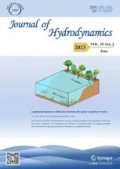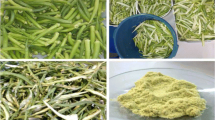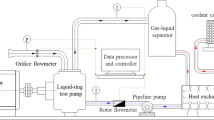Abstract
The influence of minute amounts of additives on pressure drop is an interesting fundamental phenomenon, potentially with important practical applications. Change of the pressure drop in a quasi-two-dimensional channel flow using various additives is experimentally investigated. Tests were conducted for a wide range of concentrations (100 ppm-500 ppm) and Reynolds numbers (16 000–36 000) with two polymers and four rigid fibers used as additive. Maximum drag reduction of 22% was observed for xanthan gum. However, xanthan gum loses its drag-reducing property rapidly. It was also seen that drag reduction percentage of xanthan gum remains almost constant for different Reynolds numbers. Guar flour demonstrated good drag reduction property at high Reynolds numbers. Drag reduction of 17.5% at Re = 33 200 using 300 ppm solution was observed. However, at low Reynolds numbers guar flour will cause an increase in pressure drop. Fiber fillers (aspect ratio=21) have been tested as well. In contrast to polymers, they increased the drag for the range of examined concentrations and Reynolds numbers. Polyacrylonitrile fiber with three different aspect ratios (106, 200, 400) was also used, which showed an increase in pressure drop at low aspect ratios. Polyacrylonitrile fibers of larger lengths (6 mm) demonstrated minor drag-reducing effects (up to 3%).
Similar content being viewed by others
References
Shao X., Lin J., Wu T. et al. Experimental research on drag reduction by polymer additives in a turbulent pipe flow [J]. Canadian Journal of Chemical Engineering, 2002, 80(2): 293–298.
Edomwonyi-Otu L. C., Chinaud M., Angeli P. Effect of drag reducing polymer on horizontal liquid–liquid flows [J]. Experimental Thermal and Fluid Science, 2015, 64: 164–174.
Steele A., Bayer I. S., Loth E. Pipe flow drag reduction effects from carbon nanotube additives [J]. Carbon, 2014, 77(2): 1183–1186.
Shao X., Wu T., Yu Z. Fully resolved numerical simulation of particle-laden turbulent flow in a horizontal channel at a low Reynolds number [J]. Journal of Fluid Mechanics, 2012, 693: 319–344.
Uhlmann M. Interface-resolved direct numerical simulation of vertical particulate channel flow in the turbulent regime [J]. Physics of Fluids, 2008, 20(5): 53305.
Gyr A., Bewersdorff H.-W. Drag reduction of turbulent flows by additives [M]. Dordrecht, The Netherlands: Kluwer Academic, 1995.
Toms B. A. Some observations on the flow of linear polymer solutions through straight tubes at large Reynolds numbers [C]. First International Congress on Rheology. Scheveningen, The Netherlands, 1948, 135–141.
Warholic M. D., Massah H., Hanratty T. J. Influence of drag-reducing polymers on turbulence: Effects of Reynolds number, concentration and mixing [J]. Experiments in Fluids, 1999, 27(5): 461–472.
Ptasinski P. K., Nieuwstadt F. T. M., Van Den Brule B. et al. Experiments in turbulent pipe flow with polymer additives at maximum drag reduction [J]. Flow, Turbulence and Combustion, 2001, 66(2): 159–182.
Mowla D., Naderi A. Experimental study of drag reduction by a polymeric additive in slug two-phase flow of crude oil and air in horizontal pipes [J]. Chemical Engineering Science, 2006, 61(5): 1549–1554.
White C. M., Mungal M. G. Mechanics and prediction of turbulent drag reduction with polymer additives [J]. Annual Review of Fluid Mechanics, 2008, 40(1): 235–256.
Lumley J. L. Drag reduction by additives [J]. Annual Review of Fluid Mechanics, 1969, 1(1): 367–384.
Ryskin G. Turbulent drag reduction by polymers: A quantitative theory [J]. Physical Review Letters, 1987, 59(18): 2059.
Gillissen J. J. J. Polymer flexibility and turbulent drag reduction [J]. Physical Review E Statistical Nonlinear and Soft Matter Physics, 2008, 78(4): 046311.
Tabor M., De Gennes P. G. A cascade theory of drag reduction [J]. Europhysics Letters, 1986, 2(7): 519–522.
Japper-Jaafar A., Escudier M. P., Poole R. J. Turbulent pipe flow of a drag-reducing rigid “rod-like” [J]. Journal of Non-Newtonian Fluid Mechanics, 2009, 161(1-3): 86–93.
Cai S. P., Higuchi Y. Drag-reduction behavior of an unusual nonionic surfactant in a circular pipe turbulent flow [J]. Journal of Hydrodynamics, 2014, 26(3): 400–405.
Elbing B. R., Winkel E. S., Lay K. A. et al. Bubble-induced skin-friction drag reduction and the abrupt transition to air-layer drag reduction [J]. Journal of Fluid Mechanics, 2008, 612: 201–236.
Pouranfard A. R., Mowla D., Esmaeilzadeh F. An experimental study of drag reduction by nanofluids through horizontal pipe turbulent flow of a Newtonian liquid [J]. Journal of Industrial and Engineering Chemistry, 2014, 20(2): 633–637.
Radin I., Zakin J. L., Patterson G. K. Drag reduction in solid-fluid systems [J]. AIChE Journal, 1975, 21(2): 358–371.
You Z. J., Lin J. Z., Shao X. M. et al. Stability and drag reduction in transient channel flow of fibre suspension [J]. Chinese Journal of Chemical Engineering, 2004, 12(3): 319–323.
Ko G. H., Heo K., Lee K. et al. An experimental study on the pressure drop of nanofluids containing carbon nano-tubes in a horizontal tube [J]. International Journal of Heat and Mass Transfer, 2007, 50(23–24): 4749–4753.
Liu Z. H., Liao L. Forced convective flow and heat transfer characteristics of aqueous drag-reducing fluid with carbon nanotubes added [J]. International Journal of Thermal Sciences, 2010, 49(12): 2331–2338.
Lin J. Z., Xia Y., Ku X. K. Flow and heat transfer characteristics of nanofluids containing rod-like particles in a turbulent pipe flow [J]. International Journal of Heat and Mass Transfer, 2016, 93: 57–66.
Zhao F., van Wachem B. G. M. Direct numerical simulation of ellipsoidal particles in turbulent channel flow [J]. Acta Mechanica, 2013, 224(10): 2331–2358.
Picano F., Breugem W.-P., Brandt L. Turbulent channel flow of dense suspensions of neutrally buoyant spheres [J]. Journal of Fluid Mechanics, 2015, 764: 463–487.
Lin J. Z., Xia Y., Ku X. K. Pressure drop and heat transfer of nanofluid in turbulent pipe flow considering particle coagulation and breakage [J]. Journal of Heat Transfer, 2014, 136(11): 111701.
von Kármán T. Mechanische ähnlichkeit und turbulenz [C]. Proceedings of the 3rd International Congress for Applied Mechanics. Stockholm, Sweden, 1930, 85–105.
Virk P. S. Drag reduction fundamentals [J]. AIChE Journal, 1975, 21(4): 625–656.
Elghobashi S. An updated classification map of particle-laden turbulent flows [C]. IUTAM Symposium on Computational Approaches to Multiphase Flow. Berlin, Germany: Springer, 2006, 3–10.
Elghobashi S. On predicting particle-laden turbulent flows [J]. Applied Scientific Research, 1994, 52(4): 309–329.
Fornari W., Formenti A., Picano F. et al. The effect of particle density in turbulent channel flow laden with finite size particles in semi-dilute conditions [J]. Physics of Fluids, 2016, 28(3): 033301.
Garcia-Ochoa F., Santos V. E., Casas J. A. et al. Xanthan gum: Production, recovery, and properties [J]. Biotechnology Advances, 2000, 18(7): 549–579.
Soares E. J., Sandoval G. A. B., Silveira L. et al. Loss of efficiency of polymeric drag reducers induced by high Reynolds number flows in tubes with imposed pressure [J]. Physics of Fluids, 2015, 27(12): 125105.
Zhao F., George W. K., van Wachem B. G. M. Four-way coupled simulations of small particles in turbulent channel flow: The effects of particle shape and Stokes number [J]. Physics of Fluids, 2015, 27(8): 083301.
Shapiro M., Goldenberg M. Deposition of glass fiber particles from turbulent air flow in a pipe [J]. Journal of Aerosol Science, 1993, 24(1): 65–87.
Author information
Authors and Affiliations
Corresponding author
Additional information
Biography: Amir Eshghinejadfard (1983-), Male, Ph. D. Candidate
Rights and permissions
About this article
Cite this article
Eshghinejadfard, A., Sharma, K. & Thévenin, D. Effect of polymer and fiber additives on pressure drop in a rectangular channel. J Hydrodyn 29, 871–878 (2017). https://doi.org/10.1016/S1001-6058(16)60799-0
Received:
Revised:
Published:
Issue Date:
DOI: https://doi.org/10.1016/S1001-6058(16)60799-0




